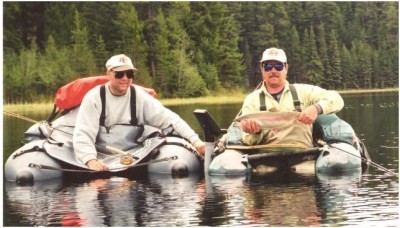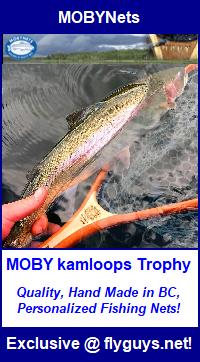Folks you’re in for a real treat! Below is an excellent post by John Scalr outlining how to fly fish full sink deep water chironomids. The article is long but it is well worth your while to read it all as it will improve your fly fishing! Thank you John for allowing us to share this on flyguys.net!
[embedit snippet=”gas-auto-responsive-link-ad-minimalist”]
Fly Fishing Chironomids
– Full Sink Deep Water Chironomids –
I’ll tell you about my deep-water technique for fly fishing Chironomids and what I’ve discovered about it so far. I am not saying that my approach is “right” or that it is complete (look for the original BC “deep water chronie fishin” post for some other really excellent tips) Just that what I am about to explain works well for me. I am, humbly, passing this along hoping that you will add your own variations and have another approach to a very productive way of fishing.
Let me start off by saying that “long-lining” with fluorocarbon leader and regular indicator is probably a more productive than the technique I will describe. But what I love about my full sink deep water chironomids approach is that I feel more involved with my fishing (retrieving the chironomid in a “known and more natural vertical rise”) and the quality of the “takes”-as I will describe– are just outstanding!!
Contrasted against this is the “sheepish” feeling you must overcome if you are an accomplished fly-fisher. You are not really “fly-fishing”, rather just “dangling” a line off the end of your rod tip like in some kind of bad “Andy Griffith type-B movie” . . . the “Huck-Fin image of dangling string off bamboo pole is really hard to shake and has kept me from really switching to and actively pursuing this method until the last season or so. Don’t let embarrassment stop you. Once you get past the stigma it’s pretty neat!
I am not sure if Phil still has the article about full sink deep water Chironomids fishing with sinking lines on his web site, but reading Rowley’s article about 4 years ago was the start of it for me. My own development of the approach is on-going; what I do now is a bit more than Phil described, but here is what I’ve developed for myself so far:
When ever I am fishing water more than 14 feet deep-and I’ve successfully used the approach all the way to 35 feet-I use hi-density type 6 sinking line (which I purchased with the intent to use specifically for full sink deep water chironomids fishing). I’ve added about five feet of fluorocarbon leader material (so I know the leader will also sink well). I am not trying to create much of a tapered leader, however I use a short section of 3X and another of lighter material-perhaps even two other lighter sections of material so the contrasting thickness from one joint to the other is not too great. It can be argued that in really clear water a longer tippet should be used, but for me a key is to “know” that you are fishing straight down and ensure you are fishing as true a depth as possible. Keeping that in mind,I add a small shot about 16” above the fly. It sinks fast, and it stays pretty much true– straight down.
On top of that I’ve marked the fly line with spray-paint every 10 feet (now I’ve only just done this and don’t know how the paint will last or effect the quality of the line’s finish over time). Beginning about 15 feet up from the leader (so when the last mark is at my hands remaining line and leader are still about 10 feet down in the water column . . . that’s five feet of line and five of leader/tippet). I continued to mark the line each ten feet on until 50 feet of my line has been marked. I use multiple bars to indicate the increasing distance: i.e. one bar at 15 feet, two bars at ten feet from there, three at another ten feet along and so on. . . . It should be noted that I don’t want the paint marks to be too bright-I don’t want them to attract fish or other attention-but I want them to be distinct enough so I can recognize them as they pass close to my hand. To finish off I’ll add that a soft-slow action rod is best used-my choice is a Scott 10’ 5w Power-ply.
With a depth sounder I have a pretty good idea of how much line to hang off to begin with . . . and as I begin to encounter fish the line marking gives me a very good idea of where in the water column I am likely to encounter trout and to be able to return to it and concentrate my fishing efforts in that zone reliably. Keeping in mind that Phil states that trout will often follow a bug up for a fair distance in the water column before taking it, if I’m getting takes twenty feet down in 40 water feet of water I’ll retrieve through the bottom depths fairly quickly, and slow down and concentrate my effort in the 20 foot area using the line-markings as my reference guide.
Typically I’m not fishing water so deep. More commonly I’m fishing about 25 feet of water. Here you don’t really have a chance to cast-that is where some of the “sheepishness” about fishing this way comes in-you just basically flip it out and let it sink and hang.
What I’ve found so far is that the full sink deep water chironomids approach is NOT a “magic-silver-bullet”. It doesn’t always work . . . and so far it has NOT been productive in every lake I’ve tried it in-but I’ve only been doing it for the past few seasons and only really used it a lot in the last couple in the places I’ve not had success it may simply be a case of “wrong time right place”. For me it becomes productive when the water is over 15 feet deep, according to the depth finder, and more typically when the finder reads that the water is 18 to 25 feet deep. Please understand: you can go for long periods of time with nothing, and then– as with any fishing — without anything really changing it turns on and it becomes ridiculously easy to catch trout!!
Another thing I like about the full sink deep water chironomids approach is that you do not need to fuss with resetting a long-line indicator; in fact, if the fish does not take any line off the reel you are ready to “re-cast” (in reality re-flip) as soon as the fish is free.
As I stated earlier, when things are right I do feel more involved with my deep water chironomids fishing– retrieving the line up (which can make a big difference) in a smooth, jerky, slow, fast, whatever motion . . . it keeps me motivated and interested. Don’t get me wrong– I love fishing indicators also and will continue to do so– but full sink deep water chironomids fishing adds a little more “technique” on my part, which I thoroughly enjoy. Most of all I love the direct contact with the fish during the take. It is amazing and at times truly heart stopping. Indeed as stated elsewhere: “Keep a somewhat loose grip on the fly line and resist the urge to lift the rod hard on a strike. There is no slack what-so-ever with this method so break-offs are common.” *
At times there is no take at all. The rod tip does not really move . . . there is just a feeling that something is “right there”. You’ve fished quietly for some time– with absolutely nothing– then you just get this “feeling” (a line sensation more than anything else). If you lift up there will be nothing on (so the trout has not taken your fly). However, upon sensing that a fish is “close”, if you move the fly up a foot or so (and if no strike is forth-coming), let the line back out settling the fly back down, wait a few seconds . . . and repeat the procedure . . . it is amazing how often that feeling becomes a grab! Usually, about 8 out of ten times, after this “line-sensation” has occurred a fish will be hooked within the next 30 seconds or so!
While “takes” can begin as just a “line-sensation”, more often there is no forewarning at all. Again, you’ve fished for a period of time, then the rod tip slowly (and I mean slowly) starts to bend down (almost as if you’ve caught bottom) the only difference here is that the rod just keeps bending. These are the takes you have to be careful of how you set up on!
But mostly full sink deep water chironomids takes are incredibly violent. You won’t have time to finish a blink, or setup or loosen-up your grip on the line! The rod tip is hovering lifeless a foot or so above the water line–the rod tip is throbbing and buried three feet down in the water column, line is screaming off the reel, and you are in awe that everything can even hold together!!
What I find most comfortable is to place the rod so it is resting cradled above the pocket of my tube (I only fish, stationary, out of tubes using this technique) with my arm and elbow resting on top of the rod and holding it in place. This allows for the tip to stay almost motionless as long as there is not too much wave action caused by the wind. In this position the rod tip is less than five feet off the end of the tube suspended about a foot above the surface.
I’d like to hold the rod in my hand more “tradition-style” and this would help steady the tip in windy conditions, but my shoulder is such that it would get tired in this position after a few minutes of time. With my other free hand I am able to hold the line and let the line hang at one depth, or slowly hand twist it up, or “jjjeeerrrkkkiiillly” hand twist it up (kinda like pretending you have Parkinson’s as you do a hand twist), or do a smooth foot strip, or a faster smooth strip with a little extra “umph” at the end.
In the case of a person fishing from a traditional boat I’d use a rod holder adjusting it so it is comfortably part-ways up the transom within easy hand reach. I’d adjust it to hold the rod horizontally, or have the tip angled slightly downwards, but always ensuring that the line is within easy reach. Doing this I believe you could pretty much duplicate what I am doing in my tube.
[embedit snippet=”gas-auto-responsive-link-ad-minimalist”]
To date my experience has shown that when things are basically “off” you are better to just let the fly hang motionless without the aid of any movement on your part. The key here is feeling confident that your fly is resting in a zone that trout will likely pass through– the old “three feet (or less) off the bottom” concept. It is hard, however, to let the fly just sit like this for long periods of time: after about five minutes you’ll wonder if you are too high or low. Of course I will begin to strip in a foot or two of line and let it rest a few minutes and repeat as needed. Then the question becomes are you, in fact, moving the fly out of the zone where trout are most likely to be frequenting? After moving the line a few feet up in several stages I will often let the line slowly slip back down into the water-my type-six line is very fine in diameter and slips easily back trough the guides– without needing to re-cast and do the whole thing all over again.
After three or four “false-retrieves” I will bring the fly all the way up to the surface: just in case the trout are, in-fact, closer to the surface and partly so I can inspect the fly. But I must confess I do this more to stay busy while waiting during slow times. Indeed, it is when I give up and let the rod hang unattended as I gaze around that I am much more likely to start getting takes.
Once I do begin to get action, things become a lot more interesting: one “take” is often followed by another a few minutes later. . . then another . . .and another. . . and then away you go! As the “bite” begins I find that just hanging the fly motionless works well. However, as the bite continues the fishing will seem to become quiet again– and I wonder to myself “is it back off, or over . . .?” It is during this phase where a bit of motion really, really, works wonders! It will seem that the trout have increased in number. A fish is almost always within range watching and waiting for a bit of motion before deciding to take your fly. This makes sense, too; during a good hatch when there are lots of natural Chironomids about adding a bit of motion to your fly so it stands out from the rest really makes a difference. Perhaps it’s just that with the heat of the day and the hatch really beginning more of the naturals are rising steadily and that is why moving the fly increases your success.
I’ve sat without a take for minutes– during what was a good bite. Growing evermore impatient because trout were taking the fly motionless quite well just a while ago. Frustrated I’ll begin to move the fly (often less than a foot) before a fish takes hold. During a feeding spell I’ve repeated this pattern time after time after time. It is no fluke. Wait long enough for the fly to fully settle; wait thirty or forty seconds longer, begin your retrieve. Hang on!
Often, the trout will not take the fly as it is moving. Instead they take it about 10 seconds after you stop whatever motion you are providing. Just about the time you think to yourself “well, there’s nothing there this time . . . ” a fish takes hold. If you move it constantly you get a lot less takes than if you move it and rest. Often these resting distances should only be a foot or so apart (about two or three hand twists, or one or two smooth strips). Moving it too far up before resting seems to cause the trout to loose interest. As you would expect, most takes under these circumstances occur within a foot or so of where you think the bottom is. You can almost imagine the fly actually resting on the bottom and then beginning to lift-off . . . trout spotting it . . . nosing up to it . . . inspecting it . . . waiting for its movement to stop . . . hesitating . . .deciding . . .deciding . . . !!!
[embedit snippet=”gas-auto-responsive-link-ad-minimalist”]
You will also find that there are times when the trout prefer one motion style to another. In the morning, as the “hatch is really starts to get underway” I’ve found that a slow hand twist really works well. As the afternoon wears on I’ve found that the fish pay more attention to a fly that is moving up a bit quicker — a smooth strip of about a foot or so, a pause for a few seconds and another strip, followed by a longer pause seems to really do the trick. These are the times when many takes occur well after the strip is finished– wait for it!! Sometimes, late in the feeding period, I’ve found the fish ignore the fly on the way up but take it on the way down (as you let the line slide slowly out) or just after you stop letting the line out and pause again before beginning another retrieve cycle. It is interesting to note how once you discover a pattern to the retrieve the same approach will be productive within seconds of re-commencing it– as if the fish are just waiting for it– and you can have five or six fish in a row in very short fishing-order until something else changes again.
One last point before I leave off: since the trout are taking the fly right below you it is absolutely unsettling to have fish come sky-rocketing out of the water about a half-second or so after the rod has whipped over and you’ve fully comprehend that a fish is on. I’ve had lots of trout smack into the rod, or do a perfect arc over the tip and foul the line on the rod on their way down. On top of that, trout will often hit the side of the tube as they land making you reflexively duck-and-cover . . . Occasionally, your hooked trout will even fall on the casting apron-and all hell breaks loose- before thrashing back off into the water and dashing madly away.
Now that’s excitement!
*** for more still water fly fishing strategies please hit up & review our still water fly fishing category here!
[embedit snippet=”gas-matched-content-ti-ar”]
Like our stuff? Subscribe by ![]() Feed or
Feed or ![]() Email
Email .jpg)










